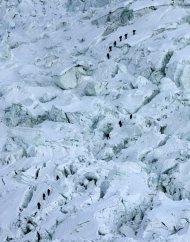By Miguel Marquez, David Molko and Holly Yan, CNN
April 29, 2014 -- Updated 1641 GMT (0041 HKT)
Near Perth, Australia (CNN) -- A private company declared that it has found what it believes is wreckage of a plane in the ocean, but leaders of the search for the missing Malaysia Airlines Flight 370 are dismissing the claim.
The reasons for the skepticism are obvious -- the site where GeoResonance says it found the wreckage, in the Bay of Bengal, is several thousand miles away from the current search area in the southern Indian Ocean.
The Joint Agency Coordination Centre, which is coordinating the multinational search, dismissed the claim.
"The Australian-led search is relying on information from satellite and other data to determine the missing aircraft's location," the JACC said.
"The location specified by the GeoResonance report is not within the search arc derived from this data. The joint international team is satisfied that the final resting place of the missing aircraft is in the southerly portion of the search arc." Malaysian acting Transportation Minister Hishammuddin Hussein said Malaysia "is working with its international partners to assess the credibility of this information."
GeoResonance said it analyzes super-weak electromagnetic fields captured by airborne multispectral images. "The company is not declaring this is MH370, however it should be investigated," GeoResonance said in a statement.
The company's director, David Pope, said he did not want to go public with the information at first, but his information was disregarded. "We're a large group of scientists, and we were being ignored, and we thought we had a moral obligation to get our findings to the authorities," he told CNN's "New Day" on Tuesday.
GeoResonance's technology was created to search for nuclear, biological and chemical weaponry under the ocean or beneath the earth in bunkers, Pope said. The company began its search four days after the plane went missing and sent officials initial findings on March 31, Pope said. It followed up with a full report on April 15.
By going public, the company says it hopes it will spur officials to take its claim seriously. Malaysian authorities contacted GeoResonance on Tuesday and were "very interested, very excited" about the findings, Pope said. Inmarsat, the company whose satellite had the last known contact with MH370, remains "very confident" in its analysis that the plane ended up in the southern Indian Ocean, a source close to the MH370 investigation told CNN.
The Inmarsat analysis is "based on testable physics and mathematics," the source said, and has been reviewed by U.S., British and Malaysian authorities as well as an independent satellite company.
Aerial search ends
After seven weeks of intense but fruitless searching, the international air effort to find the plane is over. But some ships will stay on the Indian Ocean to gather any debris that might surface. More than 600 military personnel from at least seven countries solemnly posed in front of search planes Tuesday for a commemorative photo. Some traded military patches and mulled over their disappointment in not finding the Boeing 777.
Also on Tuesday, relatives of missing passengers heard new details from officials, including audio recordings from the plane that had never been released to the public before. The final words between the cockpit and a control tower weren't extraordinary. But after 52 days in limbo, families say they're finally starting to get some of the answers they've been looking for.
More intense underwater search
Most of the international air crews will leave the Royal Australian Air Force Base Pearce, near Perth, over the next few days. The likelihood of finding any debris on the ocean's surface is "highly unlikely," Australian Prime Minister Tony Abbott said Monday. By now, most of the debris is probably waterlogged and has probably sunk, he said. So officials are moving on to the next phase: a more intense underwater search that will use private contractors and could cost about $56 million.
Crews will now scour a much larger area of the ocean floor -- 60,000 square kilometers. The process could take at least six to eight months, officials said. The Bluefin-21 underwater probe will continue scanning the ocean floor. But the submersible couldn't search Tuesday because of weather and very high seas.
No one knows exactly what happened to Flight 370, which disappeared on March 8 with 239 people on board. The plane was headed from Kuala Lumpur, Malaysia, to Beijing.
New details for relatives
Relatives of Chinese passengers have been furious about the perceived lack of information given by Malaysian authorities. But on Tuesday, Malaysian officials briefed scores of family members in Beijing and played never-before-released audio of the plane's final chatter with a control tower. "Malaysia three seven zero contact Ho Chi Minh 120.9, good night," says a voice identified by Malaysian officials as that of a radar controller in Kuala Lumpur.
"Good night Malaysian three seven zero," answers a male voice believed to be a crew member on board. Officials also showed family members maps of the flight's route, including a questionable turn at Penang over the Strait of Malacca. That turn sent the plane veering far off course.
Malaysia Airlines representative Subas Chandran said the plane probably ran out of fuel about seven-and-a-half hours into the flight. Such details, while sobering, were welcomed by relatives. "They are making progress," said Jimmy Wang, a member of the families' committee aimed at seeking answers.
Source: http://edition.cnn.com

















